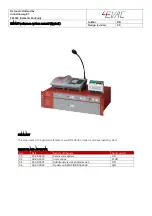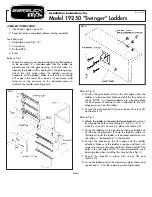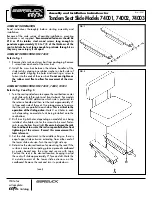
10
CentriMag
TM
pumps
Drainage cannulas
Return cannulas
2
nd
Generation CentriMag
TM
console with motor and flow probe connected
Preassembled circuit and priming pack
Two 3/8” two-sided, straight, barbed connectors (and backups), if not included with the cannula kits
Sterile tubing clamps and scissors
One liter of a warm balanced electrolyte solution for priming
Small nylon bands (~3” in length)
Typical Priming Pack Procedure
The priming pack procedure should be performed using aseptic techniques. To prime the pump:
1.
Open the priming pack. Open the pump package. Attach the drainage tubing and return tubing to the appropriate barbed ports of
the pump. Suspend the recirculation bag from an IV pole.
CAUTION: The outside of pump packaging is not sterile.
2.
When possible, flush the recirculation bag and circuit with CO
2
to remove air. Clamp the outlet lines from the reservoir bag. Fill
the reservoir bag with one liter of a balanced electrolyte solution. Open the reservoir bag air vent line.
CAUTION: Maintain an adequate level of priming solution in your reservoir bag at all times to prevent depriming the
circuit.
3.
Raise the pump up to the level of the bag. Remove the clamps from the reservoir bag outlet lines. Slowly fill the circuit with
fluid by “walking” the fluid through the circuit, while venting the air through the vent line.
CAUTION: When the clamps are removed, ensure that you are priming the tubing slowly to minimize the risk of air entrainment.
4.
Secure and lock the pump in the motor mount and recirculate the fluid at a low flow of approximately 1500 RPMs.
CAUTION: Ensure that the pump is properly seated, aligned, and locked into the motor.
Submersion Priming Technique
Typical Contents
The following is a suggested list of equipment and supplies that may be used for this technique.
CentriMag pumps
Drainage cannulas
Return cannulas
2
nd
Generation CentriMag console with motor and flow probe connected
Standard 3/8”ID x 3/32” wall tubing
Two 3/8” straight barbed connectors per pump, if not included with the cannula kits
Sterile tubing clamps and scissors
Three liters of warm balanced electrolyte solution
Bulb syringe and scissors
Small nylon bands (~ 3” in length)
Submersion Technique – Dry Connection
The dry connection submersion technique should be performed using aseptic techniques. To prime the pump:
1.
Fill a large sterile basin with three liters of a warm balanced electrolyte solution.
2.
Open the pump package. Connect the inlet and outlet of the pump to separate segments of the tubing.
CAUTION: The outside of pump packaging is not sterile.
3.
Slowly submerge the open side of the drainage tubing segment, then gradually submerge the entire piece, allowing the tubing to
fill completely from one end to the other, remaining under the surface at all times. Allow the pump to fill and deair. Continue
filling past the pump until the return tubing segment is also filled and deaired.
CAUTION: Avoid striking the pump housing in order to force air through the circuit, as damage to the pump housing may occur.
4.
Once the circuit is completely primed and deaired, clamp both open ends of the tubing.
5.
Pass the pump off the field (leave the ends of the tubing in the basin and maintain sterility of the tubing above the area which
was passed off) and place the pump in the motor.
6.
Connect the flow probe to the return segment of the tubing.
each for univentricular support, two of each for biventricular support, plus one of each for backup.
4
For the pumps, you will need two pumps for univentricular support and three pumps for biventricular support. For the console with motor and flow probe connected, you will need one of
each for univentricular support and two of each for biventricular support.










































